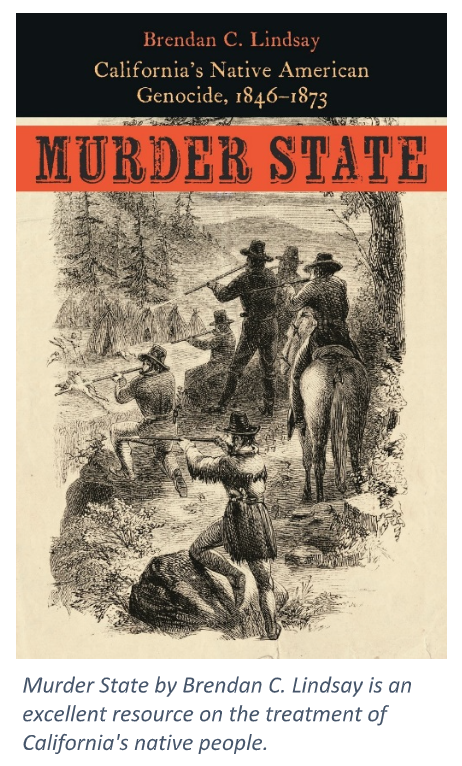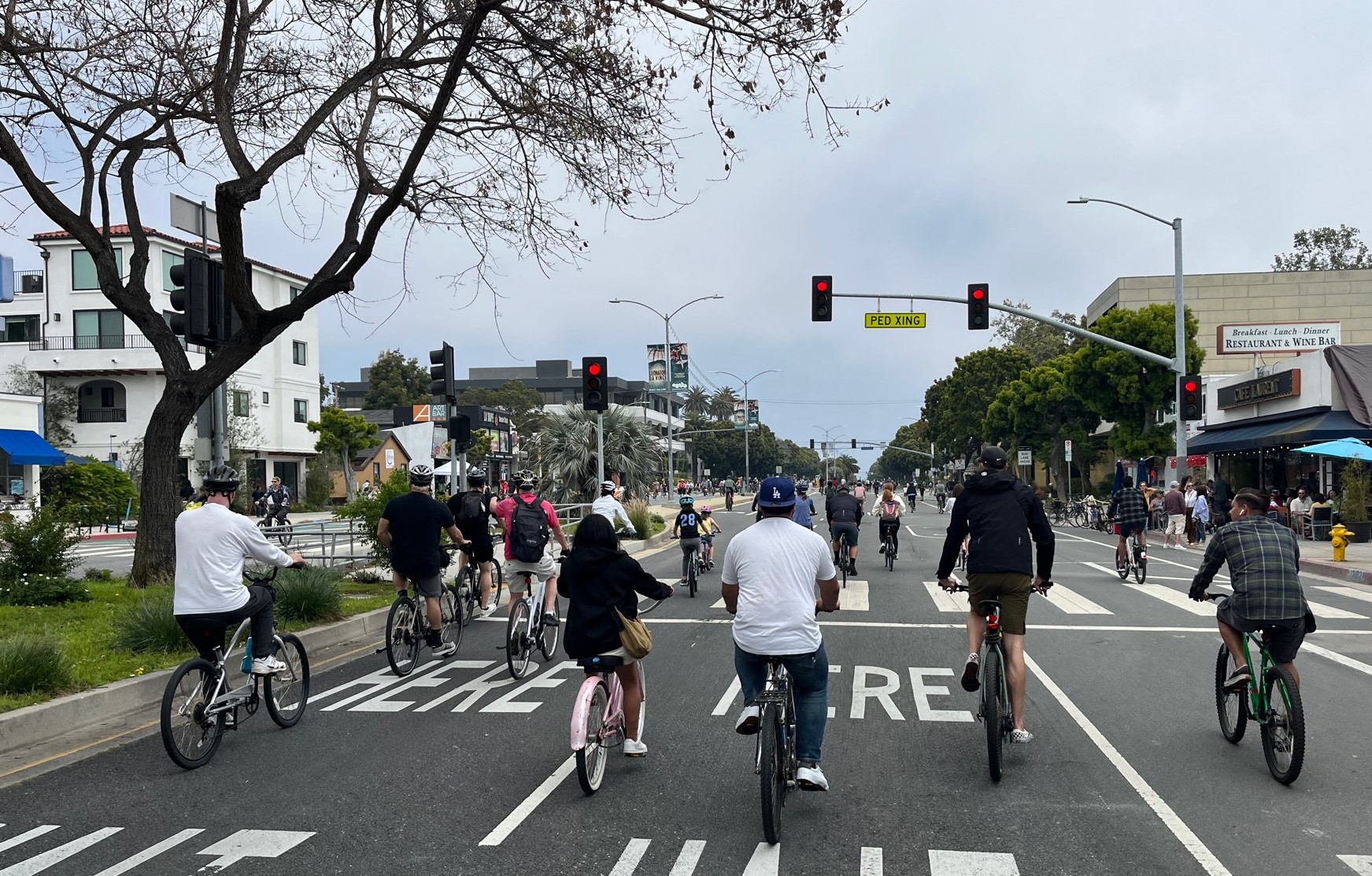Continuing to Reckon with Culver City’s Racist Past
3:33 PM PDT on June 11, 2020
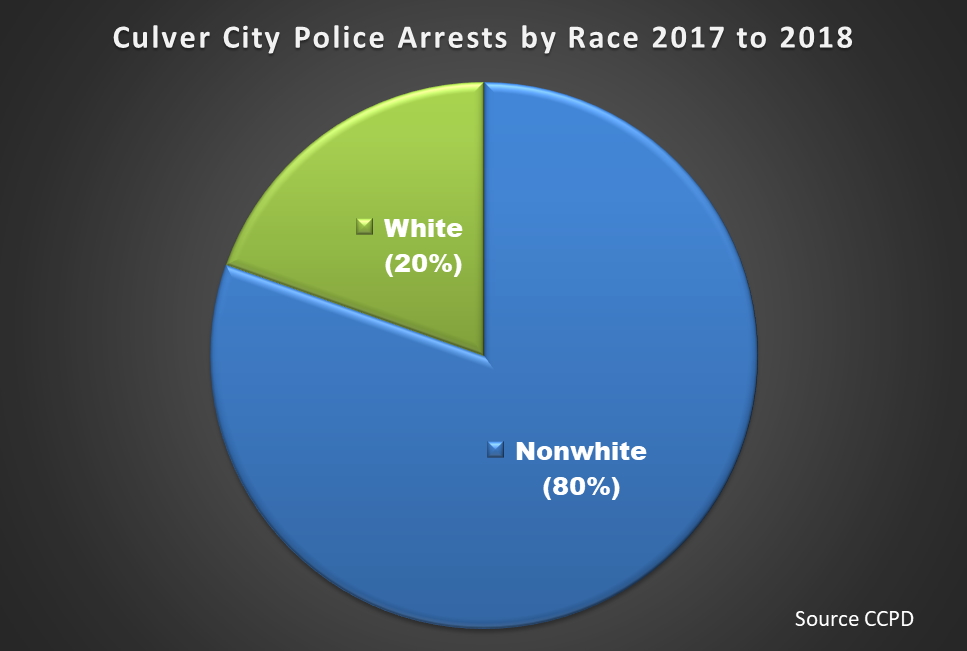
Last year, John Kent wrote "The Hidden History of Culver City Racism" for Streetsblog. The below piece builds on the research and writing from last year's work. If you have time and/or haven't read last year's article, we recommend reading "Hidden History" before reading below.- DN
Culver City’s history of racism and racist policing was documented last year in an article I wrote for Streetsblog. Perhaps unsurprisingly, many responded to the published piece asserting that they already knew about this, especially people of color. Many also said how glad they were to see it exposed. Driving through Culver City was described by nonwhites as “running a gauntlet.” One resident recalled the time “Jews Go Home” and a cross were burned into his family’s lawn. A Latina woman told of five Culver City cops beating her father for “speeding.”
This affirmed experience of the past is important. And now, especially with outrage again gripping the nation, and even the world, over the systemic racism demonstrated once more by George Floyd’s horrendous killing at the hands of the Minneapolis police, it’s essential that Culver City’s citizens and government more deeply confront our city’s history and take decisive steps. At the end of this article, I will have more to say on this.
In recent years, Culver City has become much more of an all-inclusive and vibrant place with one of the most diverse school systems in the country. In order to maintain this progressive momentum and take it to a higher level, it is necessary to rupture as fully as possible from the city’s ugly past. In expanding on my research, I have found important additional history and critical data about the city’s very recent past and our present situation that can feed into this process. Much of this concerns the city’s policing, highlighting some of the same ugly issues dramatically underlined by the killing of George Floyd.
First, some history and a brief review.
The Tongva People
Culver City occupies land stolen from the native Gabrielino-Tongva people. For millennia, the Tongva lived in areas currently part of and surrounding Culver City. One of their long-used footpaths has become the 405 freeway.[i] The wetlands at the terminus of Culver City’s Ballona Creek had been a fertile hunting and fishing area for native people going back at least 8,000 years.[ii]
California’s native people were massacred by waves of Spanish, Mexican and Euro-American invaders through a combination of slavery, disease, relocation, forced labor, imprisonment, broken treaties and a genocidal war of extermination, including paid bounties for dead “Indians.” [iii]When Culver City was founded, its whites only policies would have excluded any surviving native people.
Keeping Culver City White
As documented in my previous article, over the years numerous methods were used to attempt to keep Culver City Caucasian, including: land and deed restrictions, redlining, KKK terror and, most consistently, police harassment, incarceration and even murder. All of this was encouraged and/or tolerated by the city’s government to varying degrees.[iv] Culver City was so good at this that it’s racial restrictions were judged effective by the federal government’s Home Owners Loan Corporation (HOLC), the federal agency, which is often cited as the originator of racist redlining.[v] HOLC’s 1939 findings observed favorably that Culver City’s “[d]eed restrictions…protect against racial hazards,” and noted zero percent black residents, with the “infiltration of more Mexicans a threat but not serious.”[vi]
The Culver City Police
Much of the available evidence shows there has been consistent and ongoing racial bias within the Culver City Police Department (CCPD).
Racial Profiling

In May 2018, a Los Angeles Police Department Captain filed a legal claim against the CCPD alleging he was racially profiled. Captain Darnell Davenport, then commander of the LAPD's Southwest patrol division, said he was unjustly stopped and questioned by two Culver City officers. The claim stated, “Mr. Davenport is an avid supporter of law enforcement, thus he has been particularly disturbed by his treatment”. It went on to argue that “he cannot reconcile his detention with any justification other than the racial profiling of…African-American males.” [vii]
Dashcam video of a February 2017 traffic stop showed Culver City police officers using a choke hold to subdue black Los Angeles resident, Terry Walton, who had been passing through Culver City. [viii] This incident led to the city and several of its police officers being sued and settling out of court for $200,000.[ix] Warren SZ, a writer for the Culver City Catalyst, a local online blog, described some of what occurred:
From what can be gleaned in the dash footage, [the police officer’s choke] hold goes on for at least two minutes. That’s an extremely dangerous length of time to restrict oxygen flow to the brain…. Muscle spasms in Mr. Walton’s legs…begin triggering sporadically about 25 seconds into the hold as the officers turn him onto his chest. Interspersed with random punches from [a second police officer], the spasms go on for about a minute before Mr. Walton is still, possibly unconscious.[x]
8.8 Million Dollar Murder
In May 2013, $8.8 million was awarded to the four children of an unarmed black man killed by a Culver City police officer. Jurors in the U.S. District court deliberated for just a few hours before reaching a unanimous verdict in the 2010 death of Lejoy Grissom. The civil case for excessive force and wrongful death was brought against the Culver City Police Department and officer Luis Martinez by Grissom’s family.

Grissom was pulled over in a parking lot on suspicion he had robbed a nearby electronics store. With guns drawn, four officers and a supervisor ordered Grissom out of his car. Within moments he was shot three times by officer Luis Martinez. Grissom’s attorneys stated the other officers at the scene all testified in court that Grissom was facing them and had nothing in his hands at the time.[xi]
As frequently happens in these cases, a review by the sheriff and the district attorney determined the killing to be reasonable and lawful, even though the DA’s review cited two additional civilian witnesses who said Grissom had his hands in the air when he was shot.[xii]
I have been unable to determine whether officer Martinez was ever disciplined internally within the CCPD. I do know, however, that in 2014, the year after the jury’s $8.8 million verdict, Martinez was promoted to Sergeant.[xiii] And by 2016 Martinez had been selected president of the Culver City Police Officers Association, the police officers’ union representing all the officers and sergeants in Culver City. It seems the Department and his fellow officers were quite comfortable with his behavior.[xiv]
Racial Bias Reflected in Recent Arrest Statistics
Of course, it might be argued that these are just isolated incidents, not overall trends. Unfortunately, the most recently available CCPD arrest records confirm the trend and points to systemic problems. Over a two-year period, 2017 through 2018, 80% of those arrested by the CCPD were nonwhite (see Figure 1).[xv] Given that Culver City is about 50% white and the Westside of LA is about 60% white, these statistics should be alarming.[xvi]
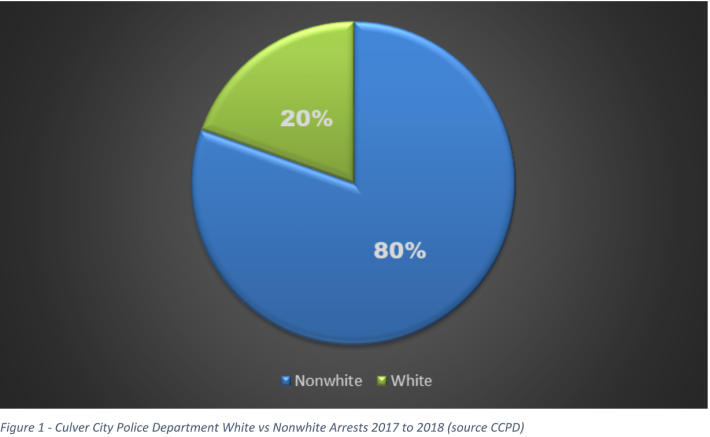
But it gets even worse with a closer look. 37% of those arrested were black people (see Figure 2) even though they represent only 8% of Culver City’s population, 5% of Westside LA, and 9% of LA County as a whole.[xvii] In other words, the arrests of black people are 4.6 to 7.4 times what we should expect with proportional arrests. This is more than alarming; it’s a three-alarm fire and a serious problem demanding to be addressed.
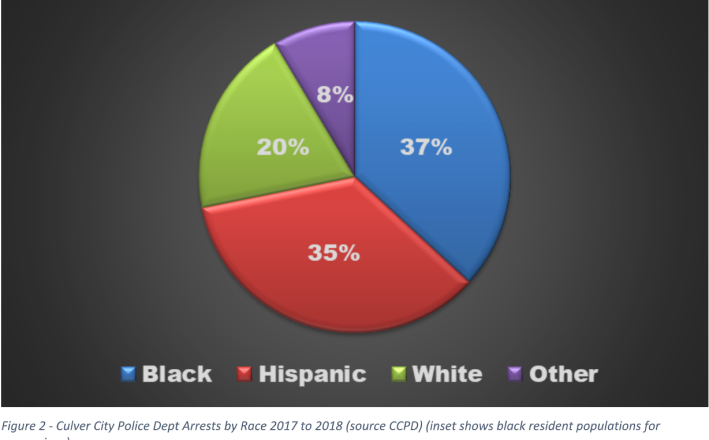
The city has taken some steps to address these issues, including providing staff training on implicit bias [xviii] and creating an advisory panel to provide the Chief of Police a “diverse, cross-section of the community’s perspective” with members appointed by the City’s Human Resources & Equity Manager.[xix] But clearly much more is needed.
Second-Generation Sundown Town Issues
Culver City has what are called second-generation sundown town issues.[xx]James Loewen, the author of Sundown Towns: A Hidden Dimension of American Racism, points out that within a city’s workforce – among police officers, teachers, and city employees there can be problems lingering from a white supremacist past.
“Sundown town police forces…may still be viewed by themselves and other residents as a city’s first line of defense against black interlopers. As a result, they engage in DWB (‘Driving While Black’) policing, targeting black motorists for minor infractions like failing to signal turns.” [xxi]
These problems often flow from underlying racial prejudices, perhaps often unconscious ones, but the results are very real. The Los Angeles area has become the national, maybe even world leader, in using intensified policing and mass incarceration as a means of controlling nonwhite populations.
Kelly Lytle Hernandez, a Culver City resident and one of the nation’s leading experts on race, immigration, and mass incarceration, writes in her award-winning book, City of Inmates: Conquest, Rebellion, and the Rise of Human Caging in Los Angeles, that LA is “a hub of incarceration.” She documents that it imprisons “more people than any other city in the United States, which incarcerates more people than any other nation on earth.”[xxii]
Culver City’s police department is an integral part of that larger picture, with their racially skewed policing and disproportionate arrests feeding the problem. More, over the years the City of Culver City seems to have rewarded the police for this behavior. Instead of reprimanding or disciplining individual officers or the department, the police budget has been generously and continuously increased – some would even call it bloated.
The Police Budget and Compensation
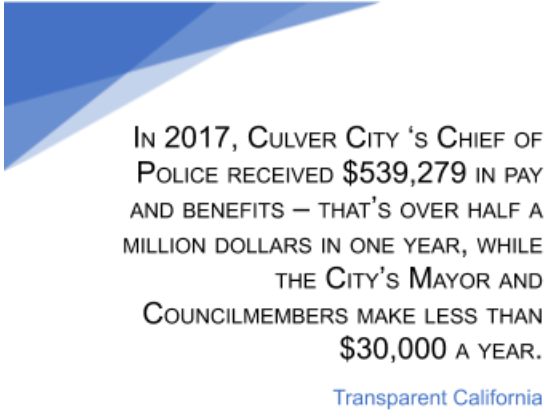
Let’s take a closer look at the budget and compensation for the CCPD relative to other city services. The values and percentages in Figure 3 are from Culver City’s general fund budget for 2019 to 2020.[xxiii] As you can see, more than $46 million, over one third of the overall budget, goes to the police department. The fire department gets a little over half of the CCPD ($27 million), while services like community development and parks and recreation receive just over 1/5th of the police budget (around $10 million each).
In other words, the police receive far more money in the city’s budget than any other city service. By way of comparison, the Los Angeles Police Department received 12.78% of the FY 2019-20 Proposed LA City Budget. [xxiv] And the Santa Monica Police and Fire Departments together received 29% of their city’s budget for FY 2019-21. [xxv]
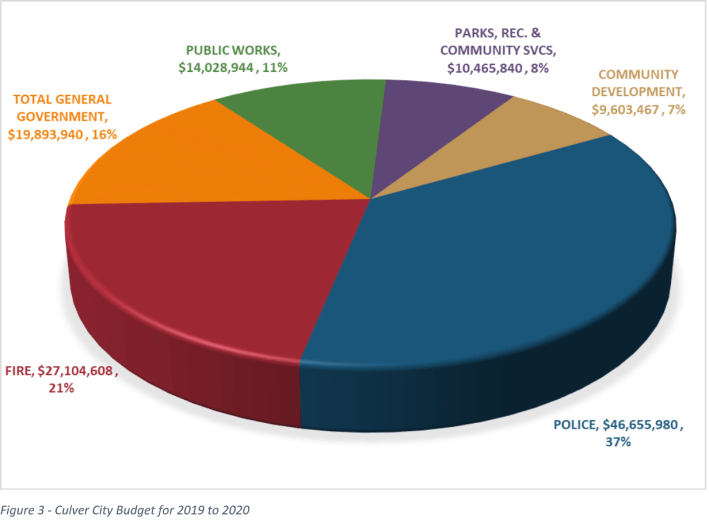
Another, perhaps more revealing, way to look at this is through individual compensation. In Table 1, I’ve collected 2017 total pay and benefits for various jobs in Culver City police and government.[xxvi] 2017 is the most recent year for which I was able to gather all the numbers. The relative ranking by total pay and benefits for each individual is in the left-hand column. As you can see, the Police Chief earns more than any other person working for the city – over half a million dollars a year! Embarrassingly, the mayor and other city council members are so far down the list they almost disappear off the bottom. Again, by way of comparison, the Los Angeles Chief of police in 2017 received $357,631 in pay and benefits; and that for a city with a 2017 population of close to 4 million, a number which dwarfs Culver City.
Does all this make the city safer?
No.
Academic studies have repeatedly shown “that a living wage, access to holistic health services and treatment, educational opportunity, and stable housing are far more successful in reducing crime than police or prisons.” [xxvii]
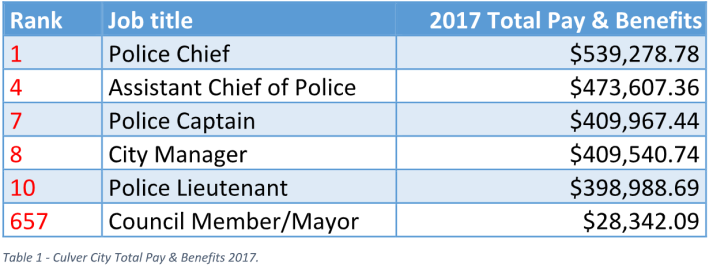
Many People Know, and Some Are Terrified
As mentioned earlier, many know about and have experienced racism in Culver City. And some of them are terrified. You may recall the nationally publicized incident in Fort Worth, Texas last October when a cop killed a black woman who was playing video games in her own home. There was a discussion on a local Culver City social media page following the shooting which elicited the following comment from a black mother:
I have a soon to be 14yo that I am allowing to start to navigate and explore Culver City with his friends and I am TERRIFIED that he might look “suspicious” to someone and the police are called and he is killed. Please do not respond with “as long as he’s not doing anything wrong he’ll be okay” or “teach him to be respectful to police and there won’t be a problem” because it is clear now that black people can be in their OWN HOMES and that does not shield them from dying from a cop’s bullet so only imagine what might happen on a public street... [xxviii]
Many others responded with similar fears and one white woman told this story she said occurred about 10 years ago:
My cousin was thinking of becoming a police officer. He did a ride-a-long with some officers in Culver City. The racism he heard from the cops during the ride a long was enough to turn him off from applying. [xxix]
Change Needed Urgently
Clearly this situation needs to change, urgently, before additional people are unjustly harassed, arrested, injured or even killed. With a progressive majority on the city council, Culver City is in a position to make amends for the city’s racist past, to work toward eliminating second-generation sundown town issues including the grossly inflated police budget, and to look for ways to make substantial changes.
The national and international upsurge of public anger unleashed by the police killing of George Floyd has created a window of opportunity to advocate for real and significant change. As an example, members of the Minneapolis City Council have just recently vowed to “dismantle” their police department and “replace it with a transformative new model of public safety.” And the Minneapolis School Board cancelled their security contract with city’s police force. Here in Culver City, the Culver City Action Network has been moving quickly to seize the initiative. They are calling on the City Council to begin by immediately cancelling the city’s planned purchase of a BearCat armored vehicle; adopt the “8 Can’t Wait" policies, which 40 years of research has shown reduces police violence by 72%; review the inflated police budget; and establish robust, independent, ongoing civilian oversight of the police.
Footnotes:
[i]Lloyd, Annie, “A Brief History of L.A.’s Indigenous Tongva People”, LAist, Oct 9, 2017, https://laist.com/2017/10/09/a_brief_history_of_the_tongva_people.php.
[ii] Western Digs, “History of Ancient Los Angeles Was Driven by Its Wetlands, 8,000-Year Survey Finds”, http://westerndigs.org/history-of-ancient-los-angeles-was-driven-by-its-wetlands-8000-year-survey-finds/.
[iv] Kent, John, “The Hidden History of Culver City Racism”, Streetsblog LA, Apr 5, 2019, https://la.streetsblog.org/2019/04/05/the-hidden-history-of-culver-city-racism/.
[v] Wikipedia, “Home Owners' Loan Corporation”, https://en.wikipedia.org/wiki/Home_Owners%27_Loan_Corporation.
[vi] 1939 HOLC findings of its appraisers and housing experts for Culver City, http://salt.umd.edu/T-RACES/data/la/ad/ad0307.pdf.
[viii]ABC Los Angeles Eyewitness News, April 21, 2018, https://abc7.com/dashcam-video-shows-culver-city-officers-use-choke-hold-to-subdue-man/3372454.
[ix] Warren SZ,Culver City Catalyst, May 21, 2018, https://culvercitycatalyst.co/ccpd-dashcam-video-investigative-series-part-3.
[x]Warren SZ, Culver City Catalyst, May 1, 2018, https://culvercitycatalyst.co/ccpd-dashcam-video-investigative-series-part-2/.
[xi] Joel Rubin,Los Angeles Times, May 9, 2013, https://www.latimes.com/local/lanow/la-xpm-2013-may-08-la-me-ln-police-verdict-20130508-story.html.
[xii] Los Angeles District Attorney’s Office review of the fatal shooting of Lejoy Grissom by Culver City Police Officer Luis Martinez, https://s3.amazonaws.com/s3.documentcloud.org/documents/1361389/2010-april-25.pdf
[xiii]Culver City Police Department Facebook page, https://www.facebook.com/CulverCityPoliceDepartment/posts/707822695956623.
[xiv]James Klein, Culver City Times , “Culver City Police Officers Association Endorses Sahli-Wells For City Council”, http://culvercitytimes.com/profiles/blogs/culver-city-police-officers-association-endorses-sahli-wells-for
[xv] This data come directly from CCPD statistics released to MuckRock News via a public records request, https://www.muckrock.com/foi/culver-city-3174/california-police-data-culver-city-police-department-77515/.
[xvi] Culver City and LA County population estimates from 2019 US Census, https://www.census.gov/quickfacts/culvercitycitycalifornia; Westside LA from LA Times & 2000 US Census, http://maps.latimes.com/neighborhoods/region/westside/.
[xviii]Culver City Race and Equity. https://www.culvercity.org/city-hall/city-government/government-alliance-on-race-and-equity.
[xix]Culver City Police Chief's Advisory Panel, https://www.culvercity.org/Home/Components/Blog/Blog/21289/3.
[xxiii] City of Culver City Adopted Budget FY 2019-2020, https://www.culvercity.org/Home/ShowDocument?id=18215.
[xxiv] City of Los Angeles, Open Budget, http://openbudget.lacity.org/#!/year/2020/operating/0/program_priority/A+Safe+City/0/department_name/Police/0/program_name.
[xxv]City of Santa Monica Adopted Biennial Budget, https://finance.smgov.net/Media/Default/annual-reports/FYE2020/FYE2020-Operating-Budget.pdf.
[xxvi]These number are from Transparent California, a public pay and pension database, https://transparentcalifornia.com/salaries/2017/culver-city/.
[xxvii] The Center for Popular Democracy, “Freedom to Thrive: Reimagining Safety & Security in Our Communities”, 2017, https://populardemocracy.org/news/publications/freedom-thrive-reimagining-safety-security-our-communities.
[xxviii]Oct 14, 2019 social media post used with permission.
Stay in touch
Sign up for our free newsletter
More from Streetsblog Los Angeles
Brightline West Breaks Ground on Vegas to SoCal High-Speed Rail
Brightline West will be a 218-mile 186-mile-per-hour rail line from Vegas to Rancho Cucamonga - about 40 miles east of downtown L.A. - expected to open in 2028
This Week In Livable Streets
Active Streets Mission-to-Mission, LAPD reports on its use of force in 2023, Pasadena Transit plans, Metro subway construction, and more
Eyes on the Street: Santa Monica Connection from E Line Bike Path to Downtown Is Almost Complete
“Always be closing gaps in your bikeway network.”
CicLAvia Opens Venice Boulevard – Open Thread
CicLAvia opened six miles of Venice Boulevard - from Culver City Station to Venice Beach
